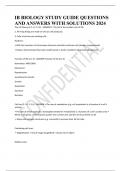Samenvatting
2.6C Anxiety and Stress - Summary problem 1, 2 and 4 + lecture notes.
- Instelling
- Erasmus Universiteit Rotterdam (EUR)
2.6C Anxiety and Stress Extensive summary Problem 1 (Stress), Problem 2 (Experimental approaches to understand anxiety) and Problem 4 (Hell is other people) + lecture notes. Summary of problem 5 is free (look at my profile).
[Meer zien]













